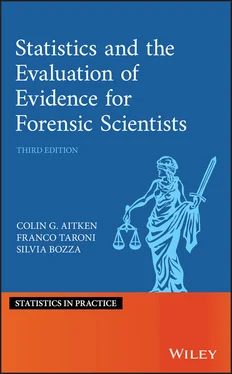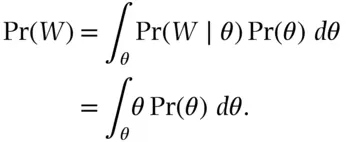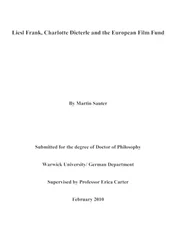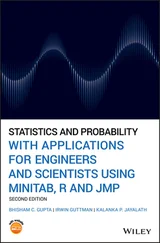Franco Taroni - Statistics and the Evaluation of Evidence for Forensic Scientists
Здесь есть возможность читать онлайн «Franco Taroni - Statistics and the Evaluation of Evidence for Forensic Scientists» — ознакомительный отрывок электронной книги совершенно бесплатно, а после прочтения отрывка купить полную версию. В некоторых случаях можно слушать аудио, скачать через торрент в формате fb2 и присутствует краткое содержание. Жанр: unrecognised, на английском языке. Описание произведения, (предисловие) а так же отзывы посетителей доступны на портале библиотеки ЛибКат.
- Название:Statistics and the Evaluation of Evidence for Forensic Scientists
- Автор:
- Жанр:
- Год:неизвестен
- ISBN:нет данных
- Рейтинг книги:3 / 5. Голосов: 1
-
Избранное:Добавить в избранное
- Отзывы:
-
Ваша оценка:
Statistics and the Evaluation of Evidence for Forensic Scientists: краткое содержание, описание и аннотация
Предлагаем к чтению аннотацию, описание, краткое содержание или предисловие (зависит от того, что написал сам автор книги «Statistics and the Evaluation of Evidence for Forensic Scientists»). Если вы не нашли необходимую информацию о книге — напишите в комментариях, мы постараемся отыскать её.
he leading resource in the statistical evaluation and interpretation of forensic evidence
The third edition of
is fully updated to provide the latest research and developments in the use of statistical techniques to evaluate and interpret evidence. Courts are increasingly aware of the importance of proper evidence assessment when there is an element of uncertainty. Because of the increasing availability of data, the role of statistical and probabilistic reasoning is gaining a higher profile in criminal cases. That’s why lawyers, forensic scientists, graduate students, and researchers will find this book an essential resource, one which explores how forensic evidence can be evaluated and interpreted statistically. It’s written as an accessible source of information for all those with an interest in the evaluation and interpretation of forensic scientific evidence.
Discusses the entire chain of reasoning–from evidence pre-assessment to court presentation; Includes material for the understanding of evidence interpretation for single and multiple trace evidence; Provides real examples and data for improved understanding. Since the first edition of this book was published in 1995, this respected series has remained a leading resource in the statistical evaluation of forensic evidence. It shares knowledge from authors in the fields of statistics and forensic science who are international experts in the area of evidence evaluation and interpretation. This book helps people to deal with uncertainty related to scientific evidence and propositions. It introduces a method of reasoning that shows how to update beliefs coherently and to act rationally. In this edition, readers can find new information on the topics of elicitation, subjective probabilities, decision analysis, and cognitive bias, all discussed in a Bayesian framework.

 denote the event ‘a white ball is extracted’. Under the circumstances that balls are all indistinguishable from each other except for the colour, the subjective probability to extract a white ball can be assessed as the known proportion
denote the event ‘a white ball is extracted’. Under the circumstances that balls are all indistinguishable from each other except for the colour, the subjective probability to extract a white ball can be assessed as the known proportion  of white balls, that is,
of white balls, that is,  . Assuming the urn contains a large number of balls, so that the extraction of a few balls does not alter its composition substantially, individual draws (i.e. sampling 9 ) will be considered as with replacement and the probability of extracting a white ball at subsequent withdrawals will still be
. Assuming the urn contains a large number of balls, so that the extraction of a few balls does not alter its composition substantially, individual draws (i.e. sampling 9 ) will be considered as with replacement and the probability of extracting a white ball at subsequent withdrawals will still be  , independently on previous observations. In this way one realises a series of so‐called Bernoulli trials (Section A.2.1), where the outcome of each trial has a constant probability independent from previous outcomes.
, independently on previous observations. In this way one realises a series of so‐called Bernoulli trials (Section A.2.1), where the outcome of each trial has a constant probability independent from previous outcomes. of white balls. A subjective assessment about the outcome of a sequence of Bernoulli trials is equivalent to placing a prior distribution on
of white balls. A subjective assessment about the outcome of a sequence of Bernoulli trials is equivalent to placing a prior distribution on  . According to this, one only needs to model a prior distribution
. According to this, one only needs to model a prior distribution  for the possible values that
for the possible values that  might take: personal beliefs concerning the colour of the next ball extracted can be computed as
might take: personal beliefs concerning the colour of the next ball extracted can be computed as
 may seem, at first sight, in contradiction with statements that probability is a single number. One can have probabilities for events, or probabilities for propositions, but not probabilities of probabilities, otherwise one would have an infinite regression (de Finetti 1976). Confusion may arise from the fact that parameter
may seem, at first sight, in contradiction with statements that probability is a single number. One can have probabilities for events, or probabilities for propositions, but not probabilities of probabilities, otherwise one would have an infinite regression (de Finetti 1976). Confusion may arise from the fact that parameter  is generally termed as ‘probability of success’ . However, it is worth noting that, although it is effectively a probability, it represents a chance rather than a belief .
is generally termed as ‘probability of success’ . However, it is worth noting that, although it is effectively a probability, it represents a chance rather than a belief . is said to be exchangeable – for you, given a knowledge base – if their joint distribution is invariant under permutation. A formal definition is as follows (Bernardo and Smith 2000):
is said to be exchangeable – for you, given a knowledge base – if their joint distribution is invariant under permutation. A formal definition is as follows (Bernardo and Smith 2000): , are said to be judged exchangeable under a probability measure
, are said to be judged exchangeable under a probability measure  if the implied joint degree of belief distribution satisfies
if the implied joint degree of belief distribution satisfies  for all permutations
for all permutations  defined on the set
defined on the set  . (p. 169)
. (p. 169)










